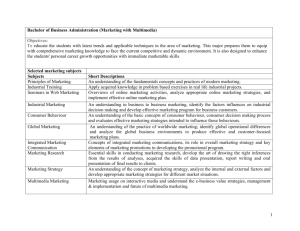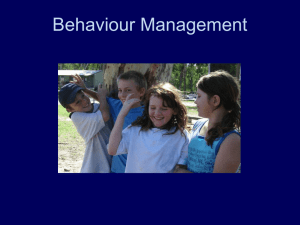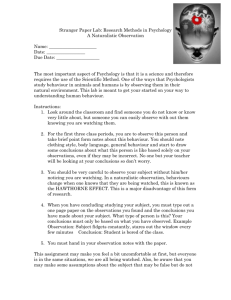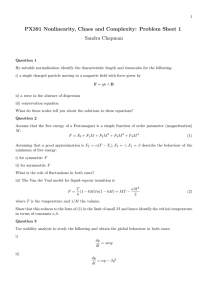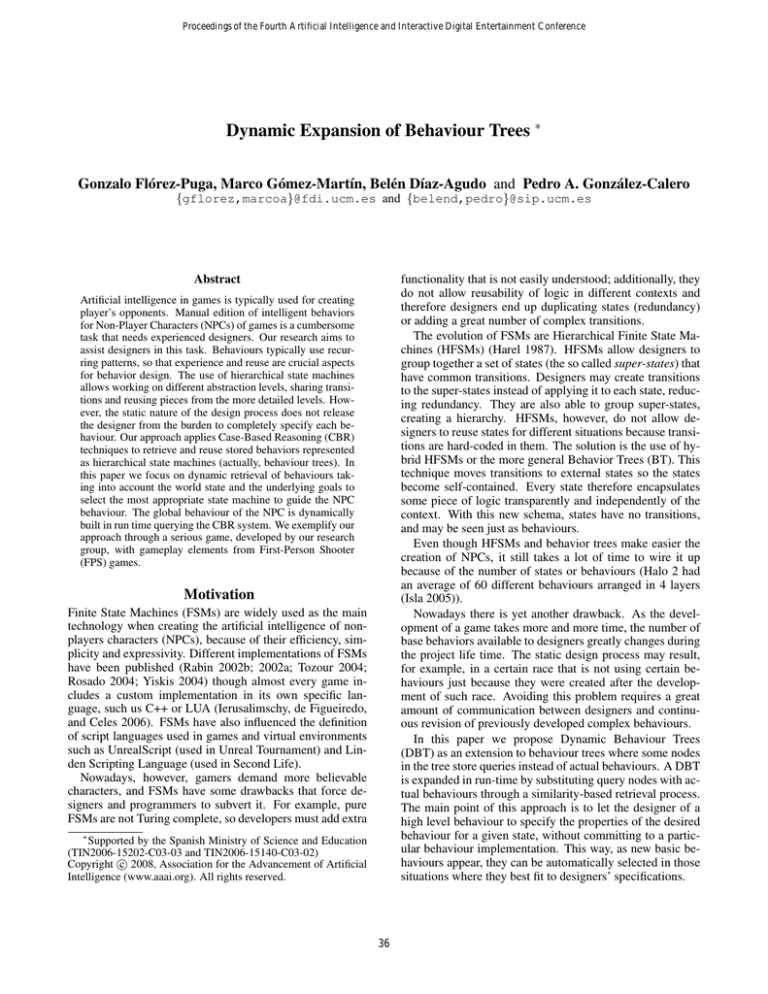
Proceedings of the Fourth Artificial Intelligence and Interactive Digital Entertainment Conference
Dynamic Expansion of Behaviour Trees ∗
Gonzalo Flórez-Puga, Marco Gómez-Martı́n, Belén Dı́az-Agudo and Pedro A. González-Calero
{gflorez,marcoa}@fdi.ucm.es and {belend,pedro}@sip.ucm.es
functionality that is not easily understood; additionally, they
do not allow reusability of logic in different contexts and
therefore designers end up duplicating states (redundancy)
or adding a great number of complex transitions.
The evolution of FSMs are Hierarchical Finite State Machines (HFSMs) (Harel 1987). HFSMs allow designers to
group together a set of states (the so called super-states) that
have common transitions. Designers may create transitions
to the super-states instead of applying it to each state, reducing redundancy. They are also able to group super-states,
creating a hierarchy. HFSMs, however, do not allow designers to reuse states for different situations because transitions are hard-coded in them. The solution is the use of hybrid HFSMs or the more general Behavior Trees (BT). This
technique moves transitions to external states so the states
become self-contained. Every state therefore encapsulates
some piece of logic transparently and independently of the
context. With this new schema, states have no transitions,
and may be seen just as behaviours.
Even though HFSMs and behavior trees make easier the
creation of NPCs, it still takes a lot of time to wire it up
because of the number of states or behaviours (Halo 2 had
an average of 60 different behaviours arranged in 4 layers
(Isla 2005)).
Nowadays there is yet another drawback. As the development of a game takes more and more time, the number of
base behaviors available to designers greatly changes during
the project life time. The static design process may result,
for example, in a certain race that is not using certain behaviours just because they were created after the development of such race. Avoiding this problem requires a great
amount of communication between designers and continuous revision of previously developed complex behaviours.
In this paper we propose Dynamic Behaviour Trees
(DBT) as an extension to behaviour trees where some nodes
in the tree store queries instead of actual behaviours. A DBT
is expanded in run-time by substituting query nodes with actual behaviours through a similarity-based retrieval process.
The main point of this approach is to let the designer of a
high level behaviour to specify the properties of the desired
behaviour for a given state, without committing to a particular behaviour implementation. This way, as new basic behaviours appear, they can be automatically selected in those
situations where they best fit to designers’ specifications.
Abstract
Artificial intelligence in games is typically used for creating
player’s opponents. Manual edition of intelligent behaviors
for Non-Player Characters (NPCs) of games is a cumbersome
task that needs experienced designers. Our research aims to
assist designers in this task. Behaviours typically use recurring patterns, so that experience and reuse are crucial aspects
for behavior design. The use of hierarchical state machines
allows working on different abstraction levels, sharing transitions and reusing pieces from the more detailed levels. However, the static nature of the design process does not release
the designer from the burden to completely specify each behaviour. Our approach applies Case-Based Reasoning (CBR)
techniques to retrieve and reuse stored behaviors represented
as hierarchical state machines (actually, behaviour trees). In
this paper we focus on dynamic retrieval of behaviours taking into account the world state and the underlying goals to
select the most appropriate state machine to guide the NPC
behaviour. The global behaviour of the NPC is dynamically
built in run time querying the CBR system. We exemplify our
approach through a serious game, developed by our research
group, with gameplay elements from First-Person Shooter
(FPS) games.
Motivation
Finite State Machines (FSMs) are widely used as the main
technology when creating the artificial intelligence of nonplayers characters (NPCs), because of their efficiency, simplicity and expressivity. Different implementations of FSMs
have been published (Rabin 2002b; 2002a; Tozour 2004;
Rosado 2004; Yiskis 2004) though almost every game includes a custom implementation in its own specific language, such us C++ or LUA (Ierusalimschy, de Figueiredo,
and Celes 2006). FSMs have also influenced the definition
of script languages used in games and virtual environments
such as UnrealScript (used in Unreal Tournament) and Linden Scripting Language (used in Second Life).
Nowadays, however, gamers demand more believable
characters, and FSMs have some drawbacks that force designers and programmers to subvert it. For example, pure
FSMs are not Turing complete, so developers must add extra
∗
Supported by the Spanish Ministry of Science and Education
(TIN2006-15202-C03-03 and TIN2006-15140-C03-02)
c 2008, Association for the Advancement of Artificial
Copyright Intelligence (www.aaai.org). All rights reserved.
36
Formalization
In order to clarify the details of our approach in this Section we will provide a formalization of the elements that we
consider in the representation of Dynamic Behaviour Trees.
In a very general settlement we propose to have:
• A set E of entities in the world. Entities have a type and
can refer to NPCs, the player, or passive entities.
Figure 1: Entity Types Taxonomy
• A set T of entity types organized in a taxonomy through
the is − a relation.
• A set B of behaviours that entities can execute. Behaviours are organized in a taxonomy through the is − a
relation.
• A set A of attributes that can be used to describe entities.
Attribute values can be numbers or symbols.
Each individual behaviour can be implemented through
primitive actions or through behaviour trees. We denote as
P the set of available primitive actions and as BT the set of
behaviour trees in a particular game.
Every behaviour implementation is described through a
behaviour b ∈ B, a set of variables, and a set of variable constraints. Variables are used to parameterize the behaviour
implementation, allowing to express, for example, that a
primitive action implements the behaviour attack to a given
entity ?target. Every variable in a behaviour implementation have to be bound to entities in E for that implementation
to be runnable. Every behaviour implementation is parameterized with at least the variable ?this which represents the
NPC who is executing the behaviour.
Variable constraints describe the applicability conditions
for a given behaviour implementation in terms of the attributes of the entities that should be used to bind its variables. Variable constraints may represent, for example, that
a given attack behaviour is best suited for ?target of type
slow − enemy of for a ?target whose aggressive attribute
is 0.7. Additionally, applicability conditions for behaviour
implementations can refer to preferred values for global
variables, such as the current difficulty level of the game or
the perceived boredom of the player.
A state s in a DBT is described through the set of behaviours Bs that the entity in that state is concurrently executing. Behaviours in a state can be references to actual
behaviour implementations (primitive actions in P or behaviour trees in BT ) or behaviour queries that when run will
retrieve the most similar behaviour implementation according to the designer specification and the current situation in
the game.
A query is essentially a partial description of a behaviour
implementation that may include the desired behaviour b ∈
B, along with a number of variables and variable constraints
using the same vocabulary used for describing applicability
conditions of behaviour implementations.
Figure 2: Behaviour Taxonomy
The use of this knowledge rich model is a strength for
our approach, as it allows describing, retrieving and reusing
behaviours. However, it could be also considered a weak
point regarding the knowledge acquisition and representation effort. We strongly support this knowledge intensive
approach because this model is reusable through different
games of the same genre, such as the First-Person Shooter
(FPS) genre that we study in this paper.
We have started by modeling the game terminology from
scratch, although being influenced from existing sources.
The Game Ontology Project (Zagal et al. 2005) is a framework for describing and analyzing games of all the genres. They have proposed a formalization abstracted from
the analysis of many specific games. The project aims to
develop a game ontology that identifies the important structural elements of games and the relationships between them,
organizing them hierarchically.
We organize the knowledge within two main taxonomies:
Entity Types (see an excerpt in Figure 1) and Behaviours
(see an excerpt in Figure 2).
Behaviour taxonomy classifies and allows the annotation
of the individual behaviour implementations that can be retrieved and reused. We use a basic classification of FPS
oriented behaviours to manage resources, to confront other
entities, either attacking or defending, to move or transport
other entities, and to hunt or chase another entities.
As we have already described, entity types are used to
characterize world entities, either NPCs, the player or passive entities. The type of a certain entity constraints the behaviour selection, as they characterize the suitable entities
to bind its variables. The entities that participate in a certain
behaviour are also constrained by attributes. The domain
model also includes properties or attributes to characterize
entities and the world. Basically, we have been influenced
here by NPC basic abilities of role-play games such as Nev-
Knowledge Modeling
According to previous section, our approach requires a
rich knowledge model about the game. Mainly, about behaviours, entities and attributes to describe entity properties.
37
erWinter Nights. These are the basic components of characters that alter how you interact with the world.
Although this vocabulary is extensible, we cite here example of properties for characters like: strength, constitution,
intelligence, wisdom, aggressiveness, defensiveness, alarm
or intuition. Difficulty is an example of a property used to
describe the world itself. Each property or ability scores
of a set of numeric or symbolic values (like little, medium,
high). There are properties applicable to all the entities and
there are properties specific for each type of entity in Figure 1. For example, aggressiveness level is a feature only
applicable to Alive Entities.
GAME STATE
Variables Value (t0 ) Value (t1 )
?this
aggressive
0.3
0.7
defensive
0.1
0.3
alarm
0.2
0.5
?player
bored
0.6
0.3
?world
difficulty
0.5
0.5
Behaviour Retrieval
In this Section we describe the proposed method for behaviour retrieval using CBR techniques. The description
is presented through examples taken from behaviours in
JV2 M1 , a serious game we have developed to teach the inner workings of the Java Virtual Machine, using gameplay
elements from First-Person Shooters (Gómez-Martı́n et al.
2007).
The context of the example query is presented in Figure 3. It corresponds to the behaviour “Steal resources (entity)”. The objective of this behaviour is to obtain resources
by stealing them from another entity, specified by an input
parameter, entity. The restrictions over the value of this parameter are that it can only be of type PLAYER, that is, the
NPC can only steal the resources from a player entity. The
adjoint table shows the attributes that describe the state of
the world in two different instants, which will give way to
two different queries. Each attribute belongs to a variable,
whose scope can be global, like ?world or ?player, or local,
like ?this (the entity that runs the behaviour) or entity (the
input parameter, not referenced in the table).
When the NPC begins executing the state machine, he
needs to expand the state “Approach and attack (entity)” into
another state machine or a primitive behaviour. The expansion implies executing the query associated and retrieving a
behaviour from the case base. The behaviour retrieved by
the query is then executed using the received parameter, entity.
To guide the retrieval process, the designer of the behaviour gives a description of the query using four elements:
Figure 3: Query context
4. Exclusions: in this section the designer can specify behaviours he wants to exclude from the candidates before
querying. The behaviours described here will never belong to the set of results of the query.
From this description, the system builds the query using
the instance values for the parameters and the values of the
variables of the relevant descriptors at the time the query is
built. This query is used to retrieve the most appropriate
behaviour from the case base.
Given the Game State and the query elements from Figure 3 we obtain two different queries, that can return different behaviours, based on the changes of the state:
Class
Parameters
?this.aggresive
?this.defensive
?this.alarm
?player.bored
?world.difficulty
Exclusions
1. Functionality: this is the class of the behaviour to be retrieved in the Behaviours taxonomy. In this case, the value
assigned to this parameter is “Attack”. Figure 2 shows the
Behaviour taxonomy with all the classes and several examples of instances of behaviours associated to them.
For this example we will use a small sample of the case
base. Table 1 gathers the cases and descriptions we will be
using. The descriptors used for the cases are very similar to
the ones used to describe the query:
1. Case number: is used to identify the case in the case base.
2. Parameters: is the set of parameters received by the behaviour, along with the restrictions of type of each one
of them. The type is obtained from the taxonomy in Figure 1. The case can only be retrieved if the type of the
2. Parameters: the designer can add parameters to the query
that will be passed to the retrieved behaviour. The parameters can be the ones received by the current behaviour or
any of the global variables.
3. Relevant descriptors: here, the designer can select which
variables and attributes of the Game State are relevant for
the query and will be used in it.
1
Query(t0 ) Query(t1 )
Attack
{(entity, PLAYER INSTANCE)}
0.3
0.7
0.1
0.3
0.2
0.5
0.6
0.3
0.5
0.5
Steal resources
http://gaia.fdi.ucm.es/projects/javy/
38
Figure 4: Persistent seek and attack
parameter in the query is compatible with the type of the
parameter in the case description.
Figure 5: Attack nearest
3. Classes: indicates to which classes of behaviours belong
the case on the behaviour taxonomy (Figure 2).
4. Descriptors: is a set of restrictions declared over the local
and global variables. The values of the descriptors can be
symbolic or numeric.
The retrieval process consists in obtaining the most appropriate behaviour from the case base, based on the query data.
To achieve this goal we compare the query with the descriptions of the behaviours in the case base using a similarity
function. The similarity function we are using is:
⎧
• C ∈ Q.exclusions ⇒ 0
⎪
⎪
⎪
⎪
• (p, v) ∈ Q.parameters ∧
⎪
⎪
⎨
(p, D) ∈ C.parameters ∧
sim (Q, C) =
v
∈
/D⇒0
⎪
⎪
⎪
⎪
•
otherwise
⇒ w · simatr (Q, C) +
⎪
⎪
⎩
(1
−
w)
·
sim
f un (Q, C)
[wa · simloc (Q.descriptors(a),
simatr (Q, C) =
a∈A(Q,C)
C.descriptors(a))]
A(Q, C) = Q.descriptors ∩ C.descriptors
|Qa .value − Ca .value|
simloc (Qa , Ca ) = 1 −
sizea
Q.class ∈ super (C.classes) ⇒ 1
simf un (Q, C) =
otherwise ⇒ 0
and attack (entity)”. To adapt the behaviour to the new conditions we query the case base again with the query(t1 ) in
the state “Approach and attack (entity)” with the new values
of descriptors. We obtain a new behaviour, “Attack nearest
(class)” (Figure 5), that is more suitable to the new Game
State. We use this newly recovered behaviour to expand the
CBR state. As we can see, the recovered behaviour has another expandable state, that will be expanded, in its moment,
with another behaviour.
An especially important issue related with the use of
CBR is identifying the moment when there has been enough
changes in the Game State so it is necessary to launch again
the query. Doing it too frequently can cause unstable behaviours and can degrade the overall performance of the
game, since the query processing can be very time consuming. Not enough frequency may cause that the behaviour
being executed is not the most appropriate for the current
situation.
Execution
Our behaviours are placed in the context of a running application that works in a loop which continuously evaluates
the changes of the virtual environment and renders the next
frame. At a given moment within the loop, this executes
the routines that define the behaviour of the NPCs. In a
multi-thread scenario, there are different approaches (Garcés
2006), but in their minimal expressions all of them end up
calling a routine that implements the decision of the NPC.
Every NPC has a dynamic behaviour tree that represents
its state. However the entire tree is not allocated in memory
but just the small numbers of behaviors actually running (the
current leaf, its parent and so on up to the root of the tree).
The current leaf always contains the primitive behaviour the
NPC is executing, while the inner nodes (including the root)
represents complex and high-level behaviours such as those
showed in Figure 3. There are two different kinds of complex behaviours in the inner nodes:
where A(Q, C) is the intersection of the sets of descriptors
of Q and C, sizea is the size of the interval of valid values for
an attribute a, and super (s) is the set of classes that subsume
the set of classes s. The weight w is a value in the interval
[0,
1]. Similarly, each wa is a value in the interval [0, 1], and
a∈A wa = 1.
For this example we will use the weights w = 0.5 and
wa = 0.2 ∀a ∈ A. The results of the similarity measure are
shown in Table 2. Results show how changes in the Game
State can lead to changes in the most suitable behaviour.
The execution goes as follows: it begins in the state “Approach and attack (entity)” from behaviour “Steal resources
(entity)” (Figure 3). This state must be expanded, so we
use the query(t0 ). As we can see in Table 2, the result of
this query is the behaviour “Persistent seek and attack (entity)” (Figure 4), as it shows the greatest similarity to the
query. The execution continues with this behaviour in the
state “Go to (entity)”. Upon reaching this point, suppose
that there is a substantial change in the Game State, in the instant t1 , while still executing the behaviour “Persistent seek
• Behaviour implementations explicitly named by the designer. Those implementations may refer to primitive actions or finite state machines (FSM) with a current state
and a set of transitions with associated conditions that,
when satisfied, fired them.
• A behaviour implementation acquired through a query described in the current state of the parent node.
39
p r o c spawn ( B e h a v i o u r b )
proc IA Tick ( Event e )
n = root node ;
w h i l e n ! = e m p t y n o d e do
i f n i s a FSM t h e n
i f c h e c k t r a n s i t i o n (n , e ) then
tear down ( n ) ;
spawn ( n e x t s t a t e ( n , e ) ;
endif
e l s e i f n i s a query then
q = build query description (n)
o t h e r b e h a v i o u r = query ( q ) ;
i f o t h e r b e h a v i o u r != n t h e n
tear down ( n ) ;
spawn ( o t h e r b e h a v i o u r ) ;
end
endif
n = child node (n );
end w h i l e
end p r o c
i f i s p r i m i t i v e b e h a v i o u r ( b ) then
game engine execute ( b )
e l s e i f is FSM ( b ) t h e n
create child ( i n i t i a l s t a t e (b))
spawn ( b )
else i f is query ( b ) then
q = build query description (b)
new b = q u e r y ( q ) ;
c r e a t e c h i l d ( new b ) ;
spawn ( new b ) ;
else
e r r o r ” Unknown b e h a v i o u r ! ” ;
endif
end p r o c
Figure 7: Pseudocode of the IA spawn routine
Figure 6: Pseudocode of the IA routine
invokes the game engine to make it executed. As it has
been previously described, the engine will report the end
of the execution of the action.
Game-loop is instructed to call the AI routine in two different moments: when the current primitive behaviour is finished or when some important event occurs (such us a collision with another entity). In order to simplify our explanation we will consider the end of the primitive behaviour as
an event.
The AI routine must visit every node in the behavior tree
to check if the event fires a change in its behaviour child.
Depending on the kind of node, that will consist on two different actions:
• When the behaviour is a FSM, it starts recursively executing its initial state.
• When the behaviour is encoded in a FSM, the event is
checked against all the conditions that define the transitions of the current state. If one of them is fired, the routine must tear the child node down (and recursively all its
descendants), and set the new state.
• When the behaviour is a query, the context that originated the retrieval of that behaviour may have changed
due to that event. To determine whether that is the case,
the query must be performed again and the behaviour retrieved is compared with the current behaviour. When
different, the current behaviour must be torn down in the
same way described before, and the retrieved behaviour
becomes the current behaviour.
Related Work and Conclusions
• When the behaviour is a query, it builds the description according to the description and the global state of
the NPC. Using that description, it retrieves the new behaviour and recursively spawn it.
The general process may be seen in Figure 7.
Alternatives to FSM have been proposed in the last years
seeking to solve the scalability problem that bigger developments with higher requirements pose for game. Goaloriented formalisms provide a declarative way for designers to express NPC behaviour, allowing for an underlying search algorithm to explore a potentially huge solution
space. Hierarchical planning have been applied both in academic (Hoang, Lee-Urban, and Muñoz-Avila 2005) and industrial systems (Gorniak and Davis 2007), and it seems to
point towards the next generation of more believable NPCs.
Nevertheless, it still has to be found the way to educate game
designers to be able to write domain descriptions and plan
preconditions and postconditions. Furthermore, designers
have to understand that a richer AI implies some degree of
emergent behaviour, where not everything can be a hundred
per cent predicted before hand.
We propose the use of dynamic behaviour trees as a middle point between fully specified behaviour trees and searchbased goal oriented formalisms. Through DBT a designer
can reuse low level behaviours without actually knowing in
advance every possible implementation for a given functionality, but being able to specify the features of the desired
behaviour, using a domain language. The ontology used to
describe behaviour queries and implementations is the con-
Most of the time, events reported by the game engine will
not fire any behaviour change and the NPC will continue
with its primitive behaviour. When the main loop informs
the routine about the end of it, the leaf node will be destroyed
and the parent node will have a transition executed. The
general process appears in Figure 6.
When a new behaviour is activated (because of a transition or a change in the result of the query) it has to be
executed. Depending on the kind of behaviour the process
differs:
• When the behaviour consists of a primitive action, it just
40
tract between high level and lower level behaviours, and it
will evolve as the set of behaviours grows.
As a future work we want to improve the knowledge
model. We are borrowing ontologies about real life, like
Military strategic and tactic knowledge or military terms.
We also plan to explore the use of Description Logics reasoning mechanisms to support the definition and evolution
of the domain ontology used to describe behaviours.
Case Parameters
Classes Descriptors
<<HFSM>> Steal resources
?this.aggressive = 0.8
?this.defensive = 0.3
1
{(entity,
Attack
?this.alarm = 0.4
PLAYER)}
Hunt
?player.bored = 0.7
?world.difficulty = 0.6
<<HFSM>> Non-persistent seek and attack
?this.aggressive = 0.3
?this.defensive = 0.1
2
{(entity,
Attack
?this.alarm = 0.7
ENTITY)}
?player.bored = 0.4
?world.difficulty = 0.2
<<HFSM>> Persistent seek and attack
?this.aggresive = 0.5
?this.defensive = 0.1
3
{(entity,
Attack
?this.alarm = 0.7
ENTITY)}
?player.bored = 0.6
?world.difficulty = 0.5
<<HFSM>> Stealth attack
?this.aggresive = 0.5
?this.defensive = 0.3
4
{(entity,
Attack
?this.alarm = 0.7
ENTITY)}
?player.bored = 0.5
?world.difficulty = 0.6
<<HFSM>> Basic hunt resources
?this.aggresive = 0.4
?this.defensive = 0.0
5
{(entity,
Hunt
?this.alarm = 0.3
ENTITY)}
?player.bored = 0.5
?world.difficulty = 0.4
<<HFSM>> Angry
?this.aggresive = 0.8
?this.defensive = 0.0
6
{(entity,
Attack
?this.alarm = 0.7
ENTITY)}
?player.bored = 0.6
?world.difficulty = 0.7
<<HFSM>> Attack nearest
?this.aggresive = 0.5
?this.defensive = 0.4
7
{(entity,
Attack
?this.alarm = 0.5
ENTITY)}
?player.bored = 0.4
?world.difficulty = 0.3
References
Garcés, S. 2006. Strategies for multiprocessor AI. In AI
Game Programming Wisdom III. Charles River Media. 65–
76.
Gómez-Martı́n, P. P.; Gómez-Martı́n, M. A.; GonzálezCalero, P. A.; and Palmier-Campos, P. 2007. Using
metaphors in game-based education. In chuen Hui et al.,
K., ed., Technologies for E-Learning and Digital Entertainment. Second International Conference of E-Learning
and Games (Edutainment’07), volume 4469, 477–488.
Gorniak, P., and Davis, I. 2007. Squadsmart: Hierarchical planning and coordinated plan execution for squads of
characters. In Schaeffer, J., and Mateas, M., eds., AIIDE,
14–19. The AAAI Press.
Harel, D. 1987. Statecharts: A visual formalism for
complex systems. Science of Computer Programming
8(3):231–274.
Hoang, H.; Lee-Urban, S.; and Muñoz-Avila, H. 2005. Hierarchical plan representations for encoding strategic game
ai. In Young, R. M., and Laird, J. E., eds., AIIDE, 63–68.
AAAI Press.
Ierusalimschy, R.; de Figueiredo, L. H.; and Celes, W.
2006. Lua 5.1 Reference Manual. Lua.org.
Isla, D. 2005. Handling complexity in the Halo 2 AI. In
Game Developers Conference.
Rabin, S. 2002a. Enhancing a state machine language
through messaging. In AI Game Programming Wisdom.
Charles River Media. 321–330.
Rabin, S. 2002b. Implementing a state machine language.
In AI Game Programming Wisdom. Charles River Media.
314–320.
Rosado, G. 2004. Implementing a data-driven finite-state
machine. In AI Game Programming Wisdom 2. Charles
River Media. 307–318.
Tozour, P. 2004. Stack-based finite-state machines. In AI
Game Programming Wisdom 2. Charles River Media. 303–
306.
Yiskis, E. 2004. Finite-state machine scripting language
for designers. In AI Game Programming Wisdom 2. Charles
River Media. 319–326.
Zagal, J.; Mateas, M.; Fernandez-Vara, C.; Hochhalter, B.;
and Lichti, N. 2005. Towards an ontological language for
game analysis. In Proceedings of the Digital Interactive
Games Research Association Conference (DiGRA 2005),
Vancouver B.C., June, 2005. Included in the Selected Papers volume.
Table 1: Case base
Query
t0
t1
C1
0.00
0.00
C2
0.90
0.88
Similarity
C3
C4
C5
0.93 0.89 0.45
0.91 0.93 0.39
Table 2: Query results
41
C6
0.87
0.89
C7
0.88
0.94

